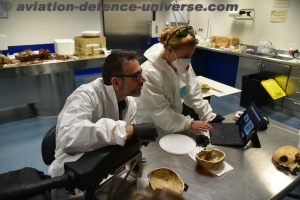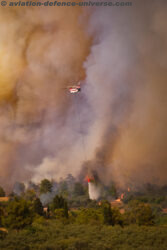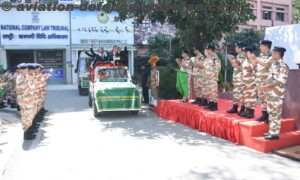- The Police of the Government of Catalonia – Mossos d’Esquadra is the second police force in the world to have this unique solution, which has attracted the interest of some of the most prestigious police forces worldwide
- Determining the distance from which a shot is fired and identifying the bullet’s trajectory is key to solving a large number of cases and, with Indra’s technology, the Catalan police force will be able to do so with all kinds of ammunition
 Madrid, May 4, 2023.- As part of the technological innovation of the Mossos d’Esquadra, the Scientific Police Division has new advanced chemical analysis equipment with LIBS technology for ballistic studies: the iForenLIBS solution. In this regard, it should be noted that the Police of Government of Catalonia is the second police force in the world to have this tool developed by Indra, in collaboration with the Spanish National Police.
Madrid, May 4, 2023.- As part of the technological innovation of the Mossos d’Esquadra, the Scientific Police Division has new advanced chemical analysis equipment with LIBS technology for ballistic studies: the iForenLIBS solution. In this regard, it should be noted that the Police of Government of Catalonia is the second police force in the world to have this tool developed by Indra, in collaboration with the Spanish National Police.
This analysis equipment represents a breakthrough for forensic studies, greatly simplifying inspection tasks and speeding up the obtaining of results in situ, since it allows capabilities that until now could only be found in a large laboratory to be transferred to the scene of the crime. The solution is based on laser-induced plasma spectroscopy, known as LIBS, a technology that enables the analysis of any substance in any state (solid, liquid or gas), by spectroscopic methods, using high-energy lasers as an excitation source.
The ten-year experience with the iForenLIBS equipment of the Spanish National Police ballistics specialists and the great results obtained and shared in forensic forums in this country and abroad have been key to the acquisition of the system by the Mossos d’Esquadra.
This innovative system stands out for its versatility: it can be carried in a backpack equipped with a laser head, which makes it a great tool for use in forensic visual ballistic inspections, where it facilitates the work of analysts with the rapid identification of the traces left following the discharge of firearms.
It is essential laboratory equipment for obtaining objective results when determining the distance from which a shot was fired, since this system provides an answer to problems that previously could not be satisfactorily solved with traditional colorimetric methods (which use reagents that undergo a measurable color change).
With the acquisition of iForenLIBS, the Central Ballistics and Trace Instruments Unit of the Forensic Science Police Division has been able to carry out studies that had previously been ruled out due to various scenarios. For example, in these first months of operation of the solution, it has been possible to provide optimal responses to several cases:
- Homicide in which the T-shirt under examination had a large amount of blood on it
At the forensic level, it is very common for the clothing of a person who has been shot to be heavily soaked in blood. In most cases, this made it impossible to obtain results with current colorimetric tests, since it was not possible to determine the distance of the shot. In the case of iForenLIBS, in the studies of these garments, it is not only possible to perform the analysis, but also to establish the shooting distance in an automated way, which makes it more objective.
- Study of a pair of pants that been shot at with lead-free ammunition
It is becoming increasingly common to find ammunition that does not contain lead or heavy elements and, in fact, most police forces use this type of ammunition. If they are used, studies to determine gunshot residues or ascertain the shooting distance are much more difficult and may even be impossible to perform with colorimetric tests. With iForenLIBS it is possible to respond to events involving any type of ammunition, both the most common ones containing lead as well as ammunition without this component.
- Search for gunshot residues and metallic residues in bone lesions
The characteristics of the equipment and its extraordinary sensitivity, which enables it to analyze any chemical element measuring just<A[medida|tamaño]> a few microns and to obtain the result practically instantaneously, makes iForenLIBS the ideal equipment to search for traces of the shot or of the projectile itself on any surface. In this regard, officers of the Scientific Police Division of the Mossos d’Esquadra have worked closely with the Institute of Legal Medicine and Forensic Sciences of Catalonia to analyze different bone samples that showed injuries compatible with a firearm projectile.
Unique solution in the world
The iForenLIBS system greatly simplifies and accelerates the chemical analysis of the remains of each bullet impact. Its excellent results have led some of the most prestigious police forces in the world to contact Indra to acquire the system, as it provides technical capabilities which are unique in the market.
Indra’s advanced system makes it possible to determine the distance by analyzing the elements that make up the various kinds of lead-free ammunition, such as boron and zinc. In addition, by screening the microscopic copper residues from the brass of the cartridges found on the surface of the clothing, it can establish the firing distance if the ammunition that was used is unknown. Through its extraordinary sensitivity, it is able to analyze particles as small as microns, one thousandth of a millimeter, very quickly.
In addition to determining the distance from which the shot was fired, iForenLIBS can help to ascertain the bullet’s angle of entry and its trajectory by analyzing the concentration of the residue left on the surface. It can also analyze a multitude of forensic samples such as glass, forgeries, etc.
All this information can prove extremely useful when it comes to solving any crime. It can check the truthfulness of the suspect’s story and provide a better understanding of what happened at the scene of a crime, building up evidence to be submitted to the judge.





























































































































